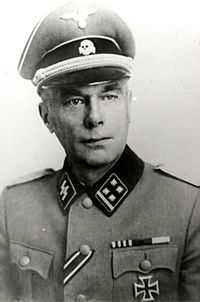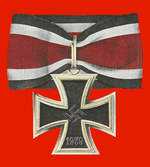Kārlis Aperāts
| Kārlis Aperāts | |
|---|---|
 | |
| Born |
4 March 1892 Vilce parish, Latvia |
| Died |
16 July 1944 (aged 52) Ssinaja Bridge |
| Allegiance |
World War I Imperial Russian Army World War II Nazi Germany |
| Service/branch |
World War II |
| Years of service |
World War I 1915–18 World War II 1939–44 |
| Rank |
World War I Second Lieutenant World War II Standartenführer |
| Unit |
World War I 1st Latvian Schützen Regiment World War II 15th Waffen Grenadier Division of the SS (1st Latvian) |
| Battles/wars |
World War I World War II |
| Awards |
|
Kārlis Aperāts (4 March 1892 – 16 July 1944) was a Standartenführer, (full colonel) in the Waffen SS during World War II. He was awarded the Knight's Cross of the Iron Cross, which was awarded to recognize extreme battlefield bravery or successful military leadership by Nazi Germany during World War II.
Early life
Kārlis Aperāts was born on the 4 March 1892, in Vilce parish, Latvia.[1]
World War I
In December 1915 during World War I, he joined the Imperial Russian Army and served in the 3rd Company, 145 Infantry Regiment on the Eastern Front fighting against the Imperial German Army. Then at his own request he was transferred into the 1st Latvian Schützen Regiment in March 1916 fighting against the Germans in the Riga area and promoted until the end of August 1917 being promoted to an NCO for his bravery in battle. In December 1917 he was admitted into hospital suffering from a severe illness, when he had recovered in December 1918 he was dismissed from the army and entered into the reserve as an officer. Then on the 31 December 1918 he was appointed commander for the Ventspils region.[2][3]
Between the wars
In January 1919 Aperāts joined the Latvian Battalion under the command of Colonel Oskars Kalpaks, and together with the Freikorps and the Iron Division was involved in fighting to liberate the Baltic states from Russian control, in command of the Wenden Battalion. In May 1919, he was given command of the signals unit of the 1st Latvian Brigade and promoted to Lieutenant in August 1919. By December 1919 he was posted to command the signals unit of the 1st Kurland Infantry Division and promoted to 1st Lieutenant.[2] In September 1920 he was transferred yet again this time to the staff of the Army high command in Riga. He was promoted to Captain in January 1924, and made the Divisional Adjutant. He took over command of the Divisions signals unit in October 1924 and made deputy chief of staff in 1928. He was promoted to Lieutenant Colonel in November 1936.[2]
World War II
After the Soviet invasion of Latvia, in 1940, Aperāts was recruited into the Red Army but left soon after to start an underground unit of 1700 men, to fight against the Red Army until June 1941, when they retreated from the advancing Germans. He joined the Waffen SS in August 1942 first in the SS Reserve Battalion, then in command of the 19th Schuma Battalion, the 26th Schumacher Battalion and from March 1943, the 19th Schumacher Battalion.[2] He was involved in operations in Belarus and on the Leningrad front from February 1943, and in March he was given command of the II.Battalion, 1st Battalion Latvian, SS Volunteer Regiment.[2] He was promoted to Obersturmbannführer in April 1943, and temporarily given command of the SS Volunteer Regiment 39 in May 1943, until June 1944 when he was moved to command the Waffen Grenadier Regiment of the SS 32 (Latvian No. 1), 15th Waffen Grenadier Division of the SS (Latvian No. 1), the regiment served in the north of the Eastern Front. Here Aperats formed a Kampfgruppe based on the SS Volunteer Grenadier Regiment 32.[2][4] The approximately 850 strong unit, with two anti tank guns were engaged by two Partisan battalions, which suffered significant losses and were destroyed. The Kampfgruppe was then selected to form the Division rearguard at the Ssinaja Bridge over the Mosuli, which was under attack by a Soviet division and 30 to 40 tanks, of which the Kampfgruppe destroyed eight. During the fighting Aperāts was severely wounded in the head and according to the regimental doctor only had about 30 minutes to live.[2] The soldiers of his Regiment wanted to carry him back to safety but he insisted that he was left behind with a pistol. As the Kampfgruppe withdrew from the bridgehead they heard a shot and it is presumed that Aperāts shot himself.[2]>[3] For his personal bravery from the 11 July 1944 south of Lake Kubenskoye and the following battles in Welikja, Aperāts was awarded a posthumous Knight's Cross.[2][3][4]
Post script
Each year on 16 July, the survivors of his regiment meet at the Ssinaja Bridge near the Mosuli, to leave a wreath on the water to remember Kārlis Aperāts.[2][3]
Promotions
- 1918 Second-Lieutenant (Latvian Army)
- 1920 First-Lieutenant (Latvian Army)
- 1924 Captain (Latvian Army)
- 1936 Lieutenant-Colonel (Latvian Army)
- 1942 Waffen-Obersturmbannführer der SS
- 1944 Waffen-Standartenführer der SS (Posthumous promotion)
References
Further reading
- Fellgiebel, Walther-Peer (2000). Die Träger des Ritterkreuzes des Eisernen Kreuzes 1939–1945 – Die Inhaber der höchsten Auszeichnung des Zweiten Weltkrieges aller Wehrmachtteile [The Bearers of the Knight's Cross of the Iron Cross 1939–1945 — The Owners of the Highest Award of the Second World War of all Wehrmacht Branches] (in German). Friedberg, Germany: Podzun-Pallas. ISBN 978-3-7909-0284-6.
- Krätschmer, Ernst-Günther (1999). Die Ritterkreuzträger der Waffen-SS [The Knight's Cross Bearers of the Waffen-SS]. Coburg, Germany: Nation Europa Verlag. ISBN 978-3-920677-43-9.
- Mitcham, Samuel W (2007). Retreat to the Reich : the German defeat in France, 1944. Mechanicsburg, PA: Stackpole Books. ISBN 978-0-8117-3384-7.
- Fey, Will; Henschler, Henri (2003). Armor Battles of the Waffen-SS. Mechanicsburg, PA: Stackpole Books. ISBN 978-0-8117-2905-5.
- Mitcham, Samuel W (2007). The German Defeat in the East, 1944–45. Mechanicsburg, PA: Stackpole Books. ISBN 978-0-8117-3371-7.
| |||||||||||||||||
| ||||||||||


